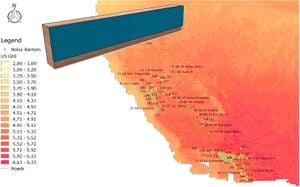
Solar photovoltaic (PV) systems have the greatest potential to meet the scale of sustainable energy demands, yet large surface areas beyond rooftop areas are required. One source of additional surface area that avoids conflict with food production while scaling with population density is noise barriers, which provide dual use of land area both as noise abatement and energy generation. This paper provides a method to quantify the potential of mass scale deployment of photovoltaic noise barrier (PVNB) systems in a country. Based on a feasibility analysis of the irradiation levels and noise barrier locations, the PV power potential and the energy output for the photovoltaic modules is calculated for specific locations using a tool chain of free GIS software. This method, is then demonstrated with a case study for the state of California and the results are then extrapolated for the entire U.S. The U.S. is an ideal candidate country because noise abatement mandates fall well short of World Health Organizations guidelines and PVNB technology has not been implemented on a wide scale. Using conservative assumptions, the results show that the total PVNB power potential for the U.S. ranges from 7 to 9 GW using only existing noise barriers. According to findings of the paper the installed capacity of the large scale photovoltaic system deployed on noise barriers in a single state is comparable to the installed capacities of the largest solar farms in the U.S. and yet due to the unique mounting of PVNB, such systems provide better land utilization ratios for energy production than conventional solar PV farms.
- Free software: QGIS project
- PV deployed on noise barriers literature review
Keywords[edit | edit source]
Solar energy; Photovoltaic; Noise barriers; Distributed generation; PVNB; Photovoltaic noise barriers
Kinds of PVNB[edit | edit source]
Types of PVNB shown in perspective and side view: a) PV modules can be mounted on the top of the barrier, b) as shingles down the side of the barrier in addition to the top, c) covering the entire vertical surface, d) a bifacial surface, e) in a horizontal zigzag configuration, and f) cassettes.
See also[edit | edit source]
- PV deployed on noise barriers literature review
- Performance and analysis of retail store‐centered microgrids with solar photovoltaic parking lot, cogeneration, and battery‐based hybrid systems
- Using LiDAR to assess rooftop solar photovoltaic potential on a large scale
- Shading losses in solar photovoltaic potential at the municipal scale
- Estimating the rooftop PV potential of a large-scale geographical region
- An open source simulation of photovoltaic yield with r.sun over large regions
- Automated quantification of solar photovoltaic potential in cities
- Technical Solar Photovoltaic Potential of Scaled Parking Lot Canopies- A Case Study of Walmart U.S.A.
- Electric Vehicle Charging Potential from Retail Parking Lot Solar Photovoltaic Awnings
- Open-source Photovoltaic - Electrical Vehicle Carport Designs






